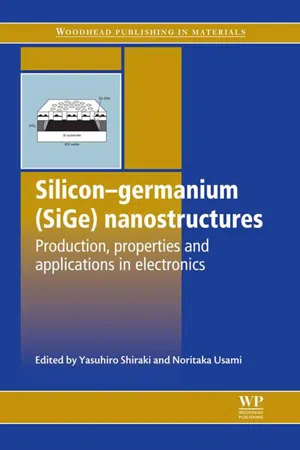
Silicon-Germanium (SiGe) Nanostructures
Production, Properties and Applications in Electronics
- 656 pages
- English
- ePUB (mobile friendly)
- Available on iOS & Android
Silicon-Germanium (SiGe) Nanostructures
Production, Properties and Applications in Electronics
About this book
Nanostructured silicon-germanium (SiGe) opens up the prospects of novel and enhanced electronic device performance, especially for semiconductor devices. Silicon-germanium (SiGe) nanostructures reviews the materials science of nanostructures and their properties and applications in different electronic devices.The introductory part one covers the structural properties of SiGe nanostructures, with a further chapter discussing electronic band structures of SiGe alloys. Part two concentrates on the formation of SiGe nanostructures, with chapters on different methods of crystal growth such as molecular beam epitaxy and chemical vapour deposition. This part also includes chapters covering strain engineering and modelling. Part three covers the material properties of SiGe nanostructures, including chapters on such topics as strain-induced defects, transport properties and microcavities and quantum cascade laser structures. In Part four, devices utilising SiGe alloys are discussed. Chapters cover ultra large scale integrated applications, MOSFETs and the use of SiGe in different types of transistors and optical devices.With its distinguished editors and team of international contributors, Silicon-germanium (SiGe) nanostructures is a standard reference for researchers focusing on semiconductor devices and materials in industry and academia, particularly those interested in nanostructures.- Reviews the materials science of nanostructures and their properties and applications in different electronic devices- Assesses the structural properties of SiGe nanostructures, discussing electronic band structures of SiGe alloys- Explores the formation of SiGe nanostructuresfeaturing different methods of crystal growth such as molecular beam epitaxy and chemical vapour deposition
Frequently asked questions
- Essential is ideal for learners and professionals who enjoy exploring a wide range of subjects. Access the Essential Library with 800,000+ trusted titles and best-sellers across business, personal growth, and the humanities. Includes unlimited reading time and Standard Read Aloud voice.
- Complete: Perfect for advanced learners and researchers needing full, unrestricted access. Unlock 1.4M+ books across hundreds of subjects, including academic and specialized titles. The Complete Plan also includes advanced features like Premium Read Aloud and Research Assistant.
Please note we cannot support devices running on iOS 13 and Android 7 or earlier. Learn more about using the app.
Information
Structural properties of silicon–germanium (SiGe) nanostructures
Abstract:
1.1 Introduction
1.2 Crystal structure



1.3 Lattice parameters

Table of contents
- Cover image
- Title page
- Table of Contents
- Copyright
- Contributor contact details
- Preface
- Part I: Introduction
- Part II: Formation of nanostructures
- Part III: Material properties of SiGe nanostructures
- Part IV: Devices using silicon, germanium and silicon–germanium (Si, Ge and SiGe) alloys
- Index